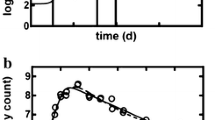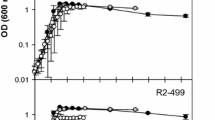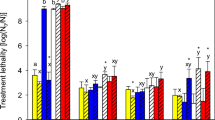Abstract
High-pressure processing (HPP) in combination with mild heat is known to have a synergistic effect on bacterial inactivation in broth, milk and meat. This synergistic effect has, however, not been documented for a ready-to-eat (RTE) soup. In this study, Listeria monocytogenes inactivation in a model RTE soup under combined high-pressure and mild-temperature (P/T) treatments was modeled according to a central composite design. The model was significant (P < 0.0001) with a satisfactory predictability (R 2adj = 0.95). Effects of P/T on L. monocytogenes inactivation were assessed by solving the deduced quadratic equation and analyzing its contour plot. More than 6-log inactivation of Listeria was possible at combined P/T ranges of 525 MPa/40 °C to 600 MPa/25 °C within 5 min. This was in accordance with FDA and EC guidance on refrigerated RTE foods that a treatment intensity equivalent to 6-log reduction of L. monocytogenes would be required as a listericidal control measure. Moreover, 600 MPa treatments at ≥45 °C for 5 min resulted in no L. monocytogenes recovery in the model soup during 3 weeks at 4 and 8 °C when the inoculum size was 103 or 105 CFU/ml. Results clearly indicated that use of mild temperatures in combination with HPP can induce a more complete inactivation, hence reducing the microbial recovery in foods after HPP. Experimental results and the fitted model in this study may be utilized as a comparison to other inactivation models and for determining test conditions for process safety assessments on similar refrigerated products in food industry.


Similar content being viewed by others

References
Hite B (1899) The effect of pressure in the preservation of milk. W Va Agric Exp Stn Bull 58:15–35
Rendueles E, Omer MK, Alvseike O, Alonso-Calleja C, Capita R, Prieto M (2011) Microbiological food safety assessment of high hydrostatic pressure processing: a review. Lwt Food Sci Technol 44(5):1251–1260
Cheftel JC (1995) Review: high-pressure, microbial inactivation and food preservation. Food Sci Technol Int 1(2–3):75–90
Knorr D (1993) Effects of high hydrostatic pressure processes on food safety and quality. Food Technol 47(6):156
Scolari G, Zacconi C, Busconi M, Lambri M (2015) Effect of the combined treatments of high hydrostatic pressure and temperature on Zygosaccharomyces bailii and Listeria monocytogenes in smoothies. Food Control 47:166–174
Abriouel H, Benomar N, Galvez A, Pulido RP (2014) Preservation of Manzanilla Alorena cracked green table olives by high hydrostatic pressure treatments singly or in combination with natural antimicrobials. Lwt Food Sci Technol 56(2):427–431
Rode TM, Hovda MB, Rotabakk BT (2015) Favourable effects of soluble gas stabilisation and modified atmosphere for suppressing regrowth of high pressure treated Listeria innocua. Food Control 51:108–113
Patterson MF, Kilpatrick DJ (1998) The combined effect of high hydrostatic pressure and mild heat on inactivation of pathogens in milk and poultry. J Food Prot 61(4):432–436
Buzrul S, Cevik M, Alpas H (2008) Comparison of response surface methodology and the proposed Weibull model for inactivation of Listeria innocua by high hydrostatic pressure. J Food Saf 28(1):142–156
Gao YL, Ju XR, Jiang HH (2006) Statistical analysis of inactivation of Listeria monocytogenes subjected to high hydrostatic pressure and heat in milk buffer. Appl Microbiol Biotechnol 70(6):670–678
Buzrul S, Alpas H (2004) Modeling the synergistic effect of high pressure and heat on inactivation kinetics of Listeria innocua: a preliminary study. FEMS Microbiol Lett 238(1):29–36
Munoz-Cuevas M, Guevara L, Aznar A, Martinez A, Periago PM, Fernandez PS (2013) Characterisation of the resistance and the growth variability of Listeria monocytogenes after high hydrostatic pressure treatments. Food Control 29(2):409–415
Bover-Cid S, Belletti N, Garriga M, Aymerich T (2011) Model for Listeria monocytogenes inactivation on dry-cured ham by high hydrostatic pressure processing. Food Microbiol 28(4):804–809
Melo J, Andrew PW, Faleiro ML (2015) Listeria monocytogenes in cheese and the dairy environment remains a food safety challenge: the role of stress responses. Food Res Int 67:75–90
Luber P (2011) The Codex Alimentarius guidelines on the application of general principles of food hygiene to the control of Listeria monocytogenes in ready-to-eat foods. Food Control 22(9):1482–1483
USFDA (2008) Control of Listeria monocytogenes in refrigerated or frozen ready-to-eat foods: draft guidance. http://www.fda.gov/Food/GuidanceRegulation/GuidanceDocumentsRegulatoryInformation/FFoodProcessingHACC/ucm073110.htm
Farber JM, Peterkin PI (1991) Listeria monocytogenes, a food-borne pathogen. Microbiol Rev 55(3):476–511
Meyer DH, Donnelly CW (1992) Effect of incubation temperature on repair of heat-injured Listeria in milk. J Food Prot 55(8):579–582
Hansen TB, Knochel S (2001) Factors influencing resuscitation and growth of heat injured Listeria monocytogenes 13-249 in sous vide cooked beef. Int J Food Microbiol 63(1–2):135–147
Ates MB, Skipnes D, Rode TM, Lekang OI (2014) Comparison of bacterial inactivation with novel agitating retort and static retort after mild heat treatments. Food Control 43:150–154
Ritz M, Tholozan JL, Federighi M, Pilet MF (2001) Morphological and physiological characterization of Listeria monocytogenes subjected to high hydrostatic pressure. Appl Environ Microbiol 67(5):2240–2247
Ritz M, Pilet MF, Jugiau F, Rama F, Federighi M (2006) Inactivation of Salmonella typhimurium and Listeria monocytogenes using high-pressure treatments: Destruction or sublethal stress? Lett Appl Microbiol 42(4):357–362
Koseki S, Yamamoto K (2007) Modelling the bacterial survival/death interface induced by high pressure processing. Int J Food Microbiol 116(1):136–143
Koseki S, Mizuno Y, Yamamoto K (2008) Use of mild-heat treatment following high-pressure processing to prevent recovery of pressure-injured Listeria monocytogenes in milk. Food Microbiol 25(2):288–293
Jofre A, Aymerich T, Bover-Cid S, Garriga M (2010) Inactivation and recovery of Listeria monocytogenes, Salmonella enterica and Staphylococcus aureus after high hydrostatic pressure treatments up to 900 MPa. Int Microbiol 13(3):105–112
Dogan C, Erkmen O (2004) High pressure inactivation kinetics of Listeria monocytogenes inactivation in broth, milk, and peach and orange juices. J Food Eng 62(1):47–52
Patterson MF (2005) Microbiology of pressure-treated foods. J Appl Microbiol 98(6):1400–1409
Bover-Cid S, Belletti N, Garriga M, Aymerich T (2012) Response surface methodology to investigate the effect of high pressure processing on Salmonella inactivation on dry-cured ham. Food Res Int 45(2):1111–1117
Bozoglu F, Alpas H, Kaletunc G (2004) Injury recovery of foodborne pathogens in high hydrostatic pressure treated milk during storage. FEMS Immunol Med Microbiol 40(3):243–247
Mujica-Paz H, Valdez-Fragoso A, Samson CT, Welti-Chanes J, Torres JA (2011) High pressure processing technologies for the pasteurization and sterilization of foods. Food Bioprocess Technol 4(6):969–985
Ross T (1996) Indices for performance evaluation of predictive models in food microbiology. J Appl Microbiol 81(5):501–508
Kalchayanand N, Sikes A, Dunne CP, Ray B (1998) Factors influencing death and injury of foodborne pathogens by hydrostatic pressure-pasteurization. Food Microbiol 15(2):207–214
Ritz M, Jugiau F, Rama F, Courcoux P, Semenou M, Federighi M (2000) Inactivation of Listeria monocytogenes by high hydrostatic pressure: effects and interactions of treatment variables studied by analysis of variance. Food Microbiol 17:375–382
Mishra N, Puri VM, Demirci A (2013) Inactivation and injury of Listeria monocytogenes under combined effect of pressure and temperature in UHT whole milk. J Food Process Eng 36(3):374–384
Chen HQ (2007) Temperature-assisted pressure inactivation of Listeria monocytogenes in Turkey breast meat. Int J Food Microbiol 117(1):55–60
Bradshaw JG, Peeler JT, Corwin JJ, Hunt JM, Tierney JT, Larkin EP, Twedt RM (1985) Thermal resistance of Listeria monocytogenes in milk. J Food Prot 48(9):743–745
Farber JM, Pagotto F (1992) The effect of acid shock on the heat-resistance of Listeria monocytogenes. Lett Appl Microbiol 15(5):197–201
Mackey BM, Bratchell N (1989) The heat resistance of Listeria monocytogenes. Lett Appl Microbiol 9(3):89–94
Chiang C (2003) Statistical methods of analysis. World Scientific, Singapore
Ross T, Baranyi J, McMeckin T (2000) Predictive microbiology and food safety. In: Robinson R, Batt C, Patel P (eds) Encyclopedia of food microbiology. Academic Press, London, pp 1699–1710
Dalgaard P (2000) Fresh and lightly preserved foods. In: Man C, Jones A (eds) Shelf life evaluation of food, 2nd edn. Aspen Publishing, Maryland, pp 110–139
Mellefont LA, McMeekin TA, Ross T (2003) Performance evaluation of a model describing the effects of temperature, water activity, pH and lactic acid concentration on the growth of Escherichia coli. Int J Food Microbiol 82(1):45–58
Munoz M, de Ancos B, Sanchez-Moreno C, Cano MP (2007) Effects of high pressure and mild heat on endogenous microflora and on the inactivation and sublethal injury of Escherichia coli inoculated into fruit juices and vegetable soup. J Food Prot 70(7):1587–1593
Uyttendaele M, Rajkovic A, Houteghem N, Boon N, Thas O, Debevere J, Devlieghere F (2008) Multi-method approach indicates no presence of sub-lethally injured Listeria monocytogenes cells after mild heat treatment. Int J Food Microbiol 123(3):262–268
Smelt JPPM (1998) Recent advances in the microbiology of high pressure processing. Trends Food Sci Technol 9(4):152–158
Bull MK, Hayman MM, Stewart CM, Szabo EA, Knabel SJ (2005) Effect of prior growth temperature, type of enrichment medium, and temperature and time of storage on recovery of Listeria monocytogenes following high pressure processing of milk. Int J Food Microbiol 101(1):53–61
Russell N (2002) Bacterial membranes: the effects of chill storage and food processing. An overview. Int J Food Microbiol 79:27–34
Smeller L (2002) Pressure–temperature phase diagrams of biomolecules. Bba Protein Struct Mol 1595(1–2):11–29
Hawley SA (1971) Reversible pressure–temperature denaturation of chymotrypsinogen. Biochemistry (Mosc) 10(13):2436
Juck G, Neetoo H, Beswick E, Chen HQ (2012) Influence of prior growth conditions, pressure treatment parameters, and recovery conditions on the inactivation and recovery of Listeria monocytogenes, Escherichia coli, and Salmonella typhimurium in turkey meat. Int J Food Microbiol 153(1–2):203–211
Hayman M, Anantheswaran C, Knabel S (2007) The effect of growth temperature and growth phase on the inactivation of Listeria monocytogenes in whole milk subject to high pressure processing. Int J Food Microbiol 115:220–226
Black EP, Huppertz T, Fitzgerald GF, Kelly AL (2007) Baroprotection of vegetative bacteria by milk constituents: a study of Listeria innocua. Int Dairy J 17(2):104–110
Shearer AEH, Neetoo HS, Chen HQ (2010) Effect of growth and recovery temperatures on pressure resistance of Listeria monocytogenes. Int J Food Microbiol 136(3):359–363
Heinz V, Buckow R (2010) Food preservation by high pressure. J Verbrauch Lebensm 5(1):73–81
Djenane D, Martinez L, Sanchez-Escalante A, Montanes L, Blanco D, Yanguela J, Beltran JA, Roncales P (2006) Effect of lactic acid bacteria on beef steak microbial flora stored under modified atmosphere and on Listeria monocytogenes in broth cultures. Food Sci Technol Int 12(4):287–295
Liao CH (2007) Inhibition of foodborne pathogens by native microflora recovered from fresh peeled baby carrot and propagated in cultures. J Food Sci 72(4):M134–M139
Acknowledgments
Mehmet Baris Ates gratefully acknowledge Ph.D. fellowship from Norconserv Foundation. Authors thank the Research Council of Norway for their financial support through Grant No. 210427.
Author information
Authors and Affiliations
Corresponding author
Ethics declarations
Conflict of interest
None.
Compliance with ethics requirements
This article does not contain any studies with human or animal objects.
Rights and permissions
About this article
Cite this article
Ates, M.B., Rode, T.M., Skipnes, D. et al. Modeling of Listeria monocytogenes inactivation by combined high-pressure and mild-temperature treatments in model soup. Eur Food Res Technol 242, 279–287 (2016). https://doi.org/10.1007/s00217-015-2539-2
Received:
Revised:
Accepted:
Published:
Issue Date:
DOI: https://doi.org/10.1007/s00217-015-2539-2



